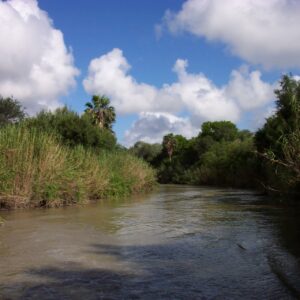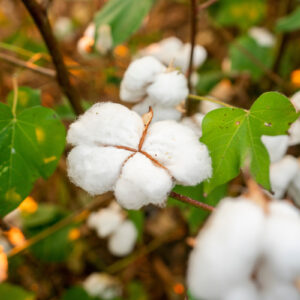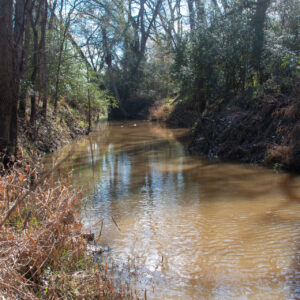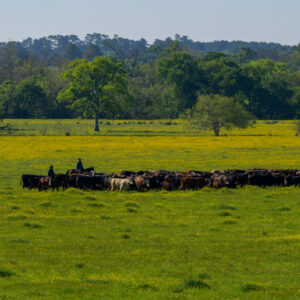Cotton performance trials were conducted during 2000 at the Lubbock, Halfway, and Pecos Texas Agricultural Experiment Stations. The Lamesa irrigated variety test was located on the Donald Love farm and the dryland variety test was on the AG-CARES research farm. Irrigated variety tests were also grown near Denver City on the Western Peanut Growers research farm and near Tulia on the Dale Swinburn farm.
The Lubbock Station tests were planted in either Amarillo or Olton soils, the Halfway Station tests in Pullman clay loam soils, and the Denver City test in Brownfield loamy fine sand soils, the Pecos Station tests were planted in Hoban silty clay loam soils.
The 2000 season began with poor soil moisture. With much of the dryland acreage to the south and irrigated to the north, above normal April and May temperatures encouraged producers to the north of Lubbock to plant before the traditional early planters to the south. Good rains in June in some areas allowed the dryland crop to be planted and get off to an excellent start. In fact, some of this dryland acreage looked just the same as irrigated, large plants with large leaves. Other dryland areas to the south of Lubbock received very little of these June rains and failed to establish a productive stand and were failed fairly early. While there was a very low acreage lost due to typical spring storms which bring hail, heavy rains and plant-stand-destroying winds, a considerable percentage of the dryland crop was lost or had their yields decreased significantly due to the lack of rains between June and September. Further weather losses occurred at the end of the season when rains and wind prevented timely harvest. Production estimates declined from 3.2 million bales in late August to less than 2.4 million bales the start of December. Weathering losses also reduced fiber quality, bringing discounts as much as $0.10 per pound.
Early season thrips infestations were lighter than in some years but their movement into cotton was over an extended period. Weather appeared to reduce the residual effectiveness of many planting insecticide treatments, requiring additional foliar sprays to compensate. Some early cold weather slowed the crop initially, resulting in more vulnerability to thrips damage.
Both cotton fleahopper and plant bug (Lygus hesperus) infestation levels were far below the record levels observed in 1999. This was probably due to the reduction in alternate wild hosts for both these species because of the drought and the impact of multiple applications of ULV malathion used in the active boll weevil eradication programs. The only area where Lygus was a problem was in the Eastern Plains area, where boll weevil eradication was yet to be initiated. It was the number one pest in that area. Other Lygus problem situations were concentrated next to cultivated alternate hosts such as potatoes, alfalfa and peanuts.
Boll weevil winter survival was reduced due to dessication in their very dry overwintering sites. Winter temperatures were not low enough to cause much mortality. Even with this mortality, boll weevil numbers emerging from overwintering sites in 2000 were high and survival of the F1 generation was also high due to the soil shading provided by lush plants resulting from June rains. As a result, multiple overwintered boll weevil applications were needed on much of the acreage in the inactive eradication zones. Boll weevil numbers exploded in late August and into September and October, requiring as many as 4-6 applications. In spite of these applications, most producers lost their top crop to weevils. This often represented a 13-25% yield reduction. Boll weevil numbers in the three active zones in the High Plains (Northwest, Permian Basin and Western) were greatly reduced by the eradication program applications. However, the Northwest Zone had some difficulty with migration from New Mexico and the inactive zones to the east and south late in the season.
Bollworm numbers were higher than last year but still at record low levels. Most fields treated for this pest were triggered by other pest problems. The severe reduction in corn acreage in the northern area greatly reduced the magnitude of bollworm infestations in August. Control problems developed in a few fields where species identification indicated the presence of pyrethroid resistant tobacco budworms.
Beet armyworm infestations were the heaviest observed since the crisis of 1980. While levels in 2000 probably equaled or even surpassed levels in 1980 in some instances, the aggressive control strategy adopted by many producers probably limited yield losses somewhat while increasing control cost substantially. These beet armyworms started in pre-squaring cotton in the Western eradication zone southwest of Lubbock and progressed northward in July and August. While their numbers were much lower in the dryland acreage they initially infested, their chronic presence and square feeding resulted in significant yield losses if not controlled. Some decisions in dryland cotton were hard to make because of the likelihood that some of the fruit protected would be lost to moisture stress. Mixed in with these beet armyworm infestations were often cabbage loopers and bollworms, and sometimes aphids and boll weevils. This made control decisions and chemical selection more difficult and more expensive. Defoliation in some cases was heavy, exceeding the 35-45% level often used to make control decisions. Late August and September infestations caused considerable defoliation and “boll grazing” damage but this resulted in very little yield loss.
The presence of multiple pests, the extended infestation period and the expense of beet armyworm control made decisions tough for producers. Some growers treated as many as four times, spending as much as $30.00 an acre for an application. Section 18’s were available for Denim, Steward and Intrepid but only Steward was available at times in sufficient quantities to make a difference. Growers were reluctant to use both Intrepid and Confirm because of their slow activity but those that did liked the level of control and extended residual activity. Most treatments consisted of either Tracer or Lorsban. Lorsban saw considerable use during the week when all the other materials were scarce. Coverage was critical for the performance of these newer materials, especially Tracer.
Cotton aphids were a sporadic pest, causing some concern early during the blooming period. High levels of lady beetles and the apparent inability of drought-stressed plants to carry very many aphids tended to keep many infestations in check. High numbers did develop as cotton opened in some fields, causing some producer concern. Fall rains eventually washed away the potential sticky cotton threat.
Overall, drought had the biggest impact directly or indirectly on production in the High Plains. These droughty conditions encouraged the buildup of beet armyworm and looper infestations and limited the management options available to many producers. The boll weevil eradication program was a great success, in spite of the associated beet armyworm problem. The Texas Boll Weevil Eradication Foundation used a sliding trap threshold to insure during times of high risk from beet armyworms that individual work unit acreage treated never exceeded 10-15% per week. While no one can determine for certain that the Foundation was entirely successful in this strategy, there is no definitive evidence to the contrary.
ACKNOWLEDGMENTS
Fiber Properties were determined at the International Textile Center, Texas Tech University with financial support from the Texas Food and Fiber Commission.
Financial Assistance was provided by the Cotton Incorporated State Support Program for the Seed Treatment tests. The financial and moral support provided by the Plains Cotton Improvement Program is invaluable as we strive to become a consistent supplier of high quality cotton.
Plot harvesting, sample ginning, and data collection were performed by: Justin Alexander, Ginger Armacost, Monica Bellow, Joe Campbell, Andy Cranmer, Johnny Fuentes, Janet Roberts, Steven Hague, Mark Hall, Casey Hardin, Ryan Heinrich, Brenda Lauderbauch, Valerie Morgan, Wes Ralston, Mike Renolds, Lyndon Schoenhals, Jessica Smith, Tisha Sparks, Anna Talbot, Raymond Tillis, Paul Ward, Leslie Wells and Steven White. Sheryl Smith provided secretarial assistance with the typing and editing of the numerous tables associated with this report. Valerie Morgan and Lyndon Schoenhals performed table preparation and statistical analyses. The assistance of all of these people is gratefully acknowledged and truly appreciated.





